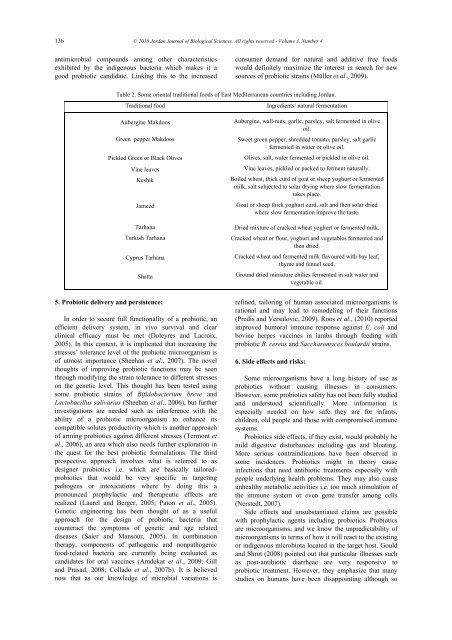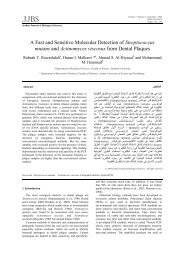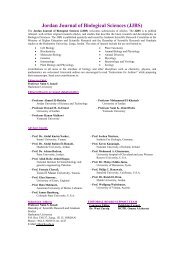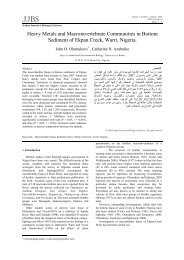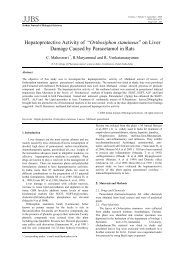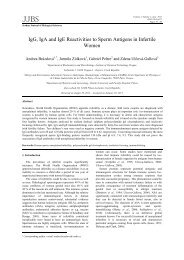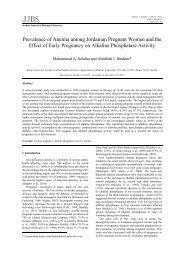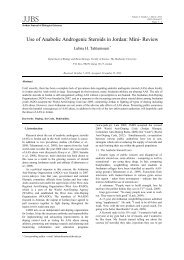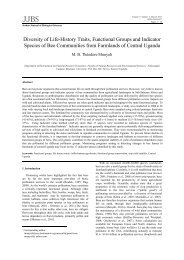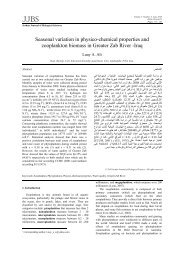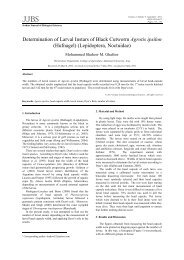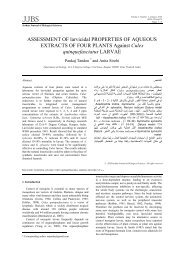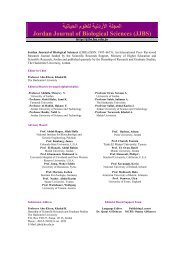Number 4 - Jordan Journal of Biological Sciences
Number 4 - Jordan Journal of Biological Sciences
Number 4 - Jordan Journal of Biological Sciences
Create successful ePaper yourself
Turn your PDF publications into a flip-book with our unique Google optimized e-Paper software.
136<br />
© 2010 <strong>Jordan</strong> <strong>Journal</strong> <strong>of</strong> <strong>Biological</strong> <strong>Sciences</strong>. All rights reserved - Volume 3, <strong>Number</strong> 4<br />
antimicrobial compounds among other characteristics<br />
exhibited by the indigenous bacteria which makes it a<br />
good probiotic candidate. Linking this to the increased<br />
consumer demand for natural and additive free foods<br />
would definitely maximize the interest in search for new<br />
sources <strong>of</strong> probiotic strains (Müller et al., 2009).<br />
Table 2. Some oriental traditional foods <strong>of</strong> East Mediterranean countries including <strong>Jordan</strong>.<br />
Traditional food Ingredients/ natural fermentation<br />
Aubergine Makdoos<br />
Green pepper Makdoos<br />
Pickled Green or Black Olives<br />
Vine leaves<br />
Keshik<br />
Jameed<br />
Tarhana<br />
Turkish Tarhana<br />
Cyprus Tarhana<br />
Shatta<br />
5. Probiotic delivery and persistence:<br />
In order to secure full functionality <strong>of</strong> a probiotic, an<br />
efficient delivery system, in vivo survival and clear<br />
clinical efficacy must be met (Doleyres and Lacroix,<br />
2005). In this context, it is implicated that increasing the<br />
stresses’ tolerance level <strong>of</strong> the probiotic microorganism is<br />
<strong>of</strong> utmost importance (Sheehan et al., 2007). The novel<br />
thoughts <strong>of</strong> improving probiotic functions may be seen<br />
through modifying the strain tolerance to different stresses<br />
on the genetic level. This thought has been tested using<br />
some probiotic strains <strong>of</strong> Bifidobacterium breve and<br />
Lactobacillus salivarius (Sheehan et al., 2006), but further<br />
investigations are needed such as interference with the<br />
ability <strong>of</strong> a probiotic microorganism to enhance its<br />
compatible solutes productivity which is another approach<br />
<strong>of</strong> arming probiotics against different stresses (Termont et<br />
al., 2006), an area which also needs further exploration in<br />
the quest for the best probiotic formulations. The third<br />
prospective approach involves what is referred to as<br />
designer probiotics i.e. which are basically tailoredprobiotics<br />
that would be very specific in targeting<br />
pathogens or intoxications where by doing this a<br />
pronounced prophylactic and therapeutic effects are<br />
realized (Laurel and Berger, 2005; Paton et al., 2005).<br />
Genetic engineering has been thought <strong>of</strong> as a useful<br />
approach for the design <strong>of</strong> probiotic bacteria that<br />
counteract the symptoms <strong>of</strong> genetic and age related<br />
diseases (Saier and Mansour, 2005). In combination<br />
therapy, components <strong>of</strong> pathogenic and nonpathogenic<br />
food-related bacteria are currently being evaluated as<br />
candidates for oral vaccines (Amdekar et al., 2009; Gill<br />
and Prasad, 2008; Collado et al., 2007b). It is believed<br />
now that as our knowledge <strong>of</strong> microbial variations is<br />
Aubergine, wall-nuts, garlic, parsley, salt fermented in olive<br />
oil.<br />
Sweet green pepper, shredded tomato, parsley, salt garlic<br />
fermented in water or olive oil.<br />
Olives, salt, water fermented or pickled in olive oil.<br />
Vine leaves, pickled or packed to ferment naturally.<br />
Boiled wheat, thick curd <strong>of</strong> goat or sheep yoghurt or fermented<br />
milk, salt subjected to solar drying where slow fermentation<br />
takes place.<br />
Goat or sheep thick yoghurt curd, salt and then solar dried<br />
where slow fermentation improve the taste.<br />
Dried mixture <strong>of</strong> cracked wheat yoghurt or fermented milk.<br />
Cracked wheat or flour, yoghurt and vegetables fermented and<br />
then dried.<br />
Cracked wheat and fermented milk flavoured with bay leaf,<br />
thyme and fennel seed.<br />
Ground dried miniature chilies fermented in salt water and<br />
vegetable oil.<br />
refined, tailoring <strong>of</strong> human associated microorganisms is<br />
rational and may lead to remodeling <strong>of</strong> their functions<br />
(Predis and Versalovic, 2009). Roos et al., (2010) reported<br />
improved humoral immune response against E. coli and<br />
bovine herpes vaccines in lambs through feeding with<br />
probiotic B. cereus and Saccharomyces boulardii strains.<br />
6. Side effects and risks:<br />
Some microorganisms have a long history <strong>of</strong> use as<br />
probiotics without causing illnesses in consumers.<br />
However, some probiotics safety has not been fully studied<br />
and understood scientifically. More information is<br />
especially needed on how safe they are for infants,<br />
children, old people and those with compromised immune<br />
systems.<br />
Probiotics side effects, if they exist, would probably be<br />
mild digestive disturbances including gas and bloating.<br />
More serious contraindications have been observed in<br />
some incidences. Probiotics might in theory cause<br />
infections that need antibiotic treatments especially with<br />
people underlying health problems. They may also cause<br />
unhealthy metabolic activities i.e. too much stimulation <strong>of</strong><br />
the immune system or even gene transfer among cells<br />
(Nerstedt, 2007).<br />
Side effects and unsubstantiated claims are possible<br />
with prophylactic agents including probiotics. Probiotics<br />
are microorganisms, and we know the unpredictability <strong>of</strong><br />
microorganisms in terms <strong>of</strong> how it will react to the existing<br />
or indigenous microbiota located in the target host. Gould<br />
and Shrot (2008) pointed out that particular illnesses such<br />
as post-antibiotic diarrheae are very responsive to<br />
probiotic treatment. However, they emphasize that many<br />
studies on humans have been disappointing although so


